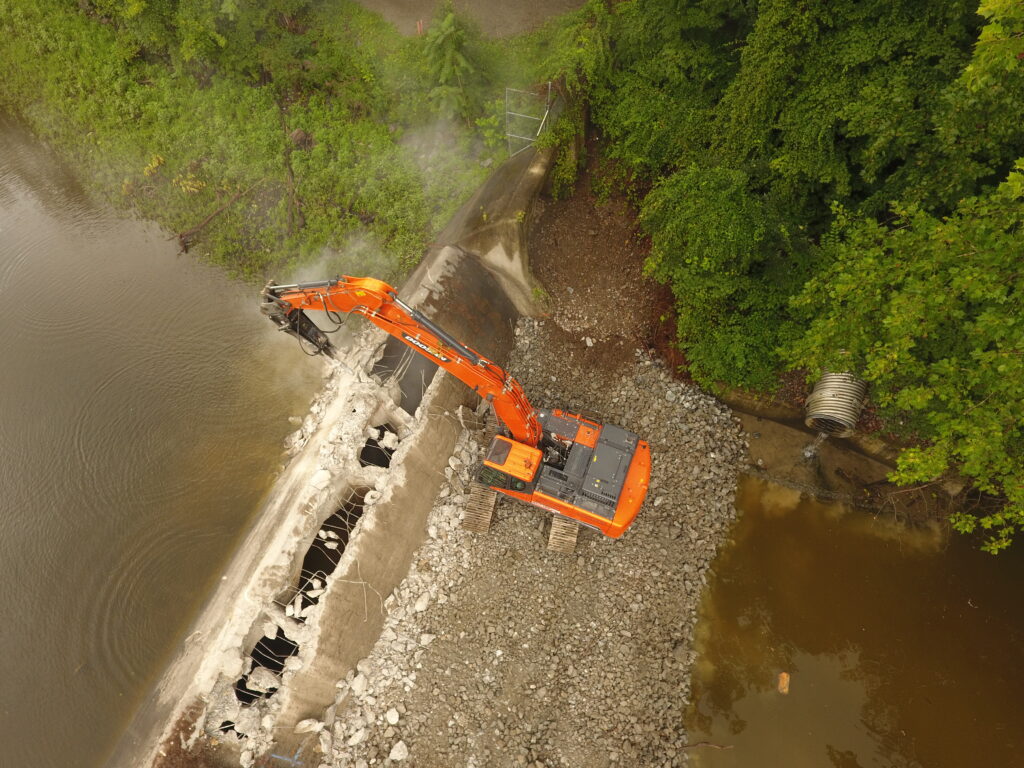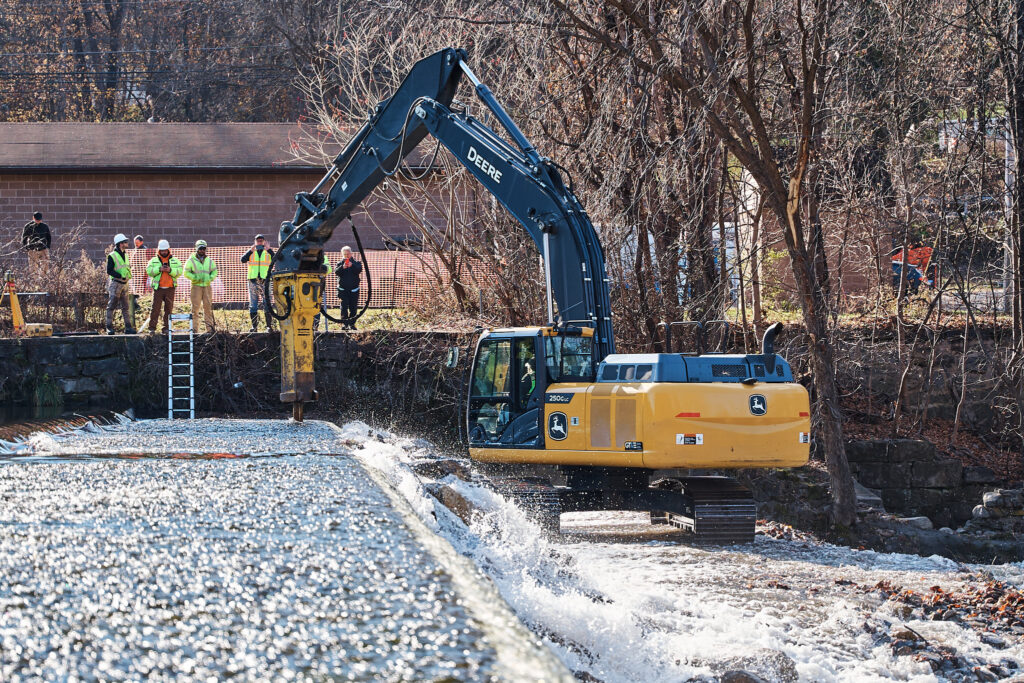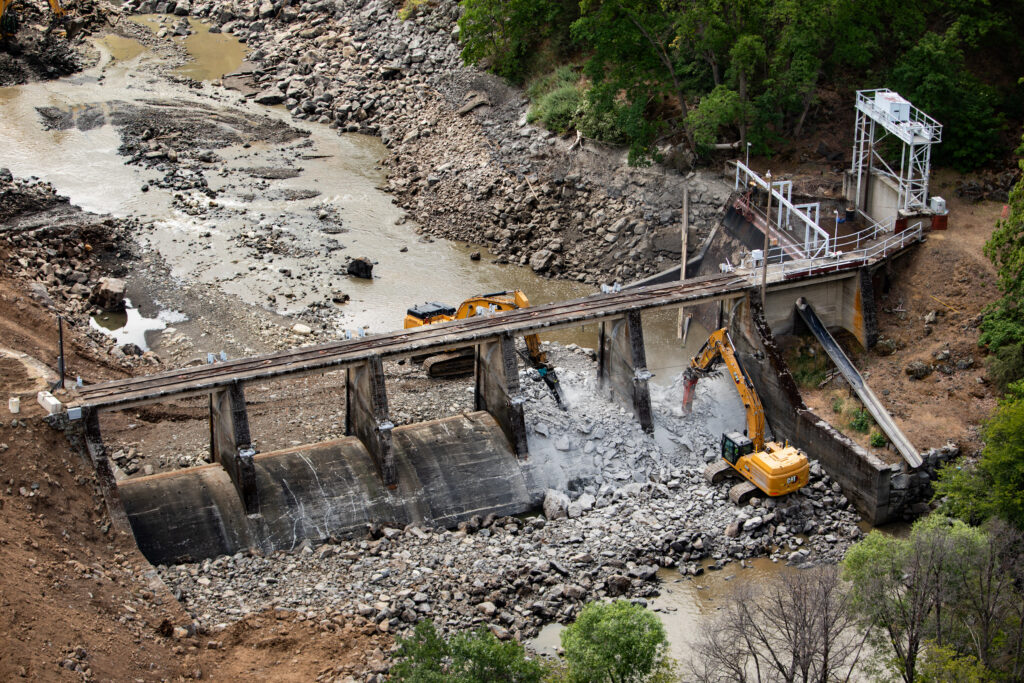Dam Removal in 2018 — Another successful year of freeing rivers
82 dams and more than 1,230 miles of river were restored through dam removal in 2018.

Communities seeking relief from flooding caused by increasingly intense storms.
Fish seeking refuge from warming downstream waters.
Parents seeking solace when their child has been pulled into the undertow of the base of an artificial waterfall (aka a dam).
Landowners pouring money into failing, obsolete structures, or perhaps pretending they do not exist at all… just waiting for the next big storm to knock them down.
The reality of living in a world with a changing climate is real, and we must ensure that we actively work towards making our rivers and communities more resilient. Now is the time to revive our rivers and streams— the lifeblood of our nation. The good news is that we are making progress.
It has been another successful year of busting dams and reconnecting rivers and streams across America. Every year the dam removal movement continues to grow stronger. In 2018, 82 dams in total were removed from across the country. Communities in 18 states worked closely with various non-profit organizations, local municipalities, state and federal agencies to remove these dams and successfully reconnect more than 1,230 river miles.
Dams were removed in the following states: California, Connecticut, Georgia, Illinois, Indiana, Maine, Maryland, Massachusetts, Michigan, Minnesota, New Hampshire, New Jersey, New York, North Carolina, Ohio, Oregon, Pennsylvania, and Wisconsin.
In 2018, California had the highest number of removals, surpassing Pennsylvania, the leading dam removal state for the past 15 years. The top three states removing outdated dams in 2018 were:
- California – 35 dams removed
- Pennsylvania – 7 dams removed
- Michigan – 7 dams removed
Over the years, the number of dam removal projects have continued to increase, with most removals (1,355) occurring over the past 30 years. Pennsylvania has the highest number of removal projects so far (337 total recorded), while other states nationwide are also stepping up to the challenge (this year’s leader, California, has 148 total removals, followed closely by Michigan with 139). From 1912 through 2018, 1,578 dams have been removed in the U.S. to restore fish passage and access to habitat, eliminate safety hazards, and reduce future liability for owners and surrounding communities.
For over a century, the U.S. has led the world in dam building. However, like all infrastructure, dams don’t last forever. Twenty years ago this July, Edwards Dam was removed from the Kennebec River in Maine. It marked the first time the federal government ordered a dam removed because its costs outweighed its benefits; it garnered worldwide attention. The Kennebec is a resounding restoration success story, with millions of fish returning every year. It inspired a movement that continues to grow, nationally and globally.
Today, many local communities have come to understand that while in some situations dams can be beneficial, they can also cause a considerable amount of harm to river ecosystems. The American Society of Civil Engineers gives the nation’s dams a D grade in its report card on the nation’s infrastructure. Therefore, dams that were once the center of communities powering mills or supplying water for some industry are subsequently being removed after wearing down or no longer serving their intended purposes.
This year, American Rivers is applauding the great progress that environmental organizations, local municipalities, state and federal agencies, landowners, and others have made towards reestablishing natural river flow and functions through dam removal. However, we are ready to do more. There are hundreds of thousands, perhaps over a million, more dams out there. Many of them are coming to the end of their useful lives. American Rivers is committed to working with our partners across the country to find ways to increase the number of dams removed each year and empower communities to restore and reconnect their rivers. We cannot do it alone.
Please join us now to help accelerate the dam removal movement!
Things you can do:
- Learn more about the benefits of dam removal
- Talk with others in your community about the benefits of dam removal
- Support the removal of outdated dams within your community
- Comment on this blog post and tell us if you know of possible projects. We will make sure to connect you with an American Rivers staffer in your region or with someone in your local community who may be able to help.
HIGHLIGHTS OF DAM REMOVAL AND RIVER RESTORATION EFFORTS IN 2018 INCLUDE:
Bloede Dam, Patapsco River, Maryland
The Bloede Dam was removed in 2018 as part of a larger plan— which included removal of the Union and Simkins dams in 2010— to restore more than 65 miles of spawning habitat for blueback herring, alewife, American shad, hickory shad, and more than 183 miles for American eel in the Patapsco River watershed. Originally built by a private company in the early 1900s to supply electricity to the cities of Catonsville in Baltimore County and Ellicott City in Howard County, the 34-foot high by 220-foot long dam, located in Patapsco Valley State Park, was most recently owned by the Maryland Department of Natural Resources. At the time of demolition, it no longer produced power or any other economic benefit, but contributed to numerous injuries and deaths, including at least nine dam-related drownings since the 1980s. Its removal reconnects habitat for one of the highest runs of river herring in the Chesapeake Bay.
Contact: Serena McClain, American Rivers, 202-347-7550, smcclain@americanrivers.org
Cleveland National Forest, California
The Cleveland National Forest removed 33 dams in total—18 dams from Holy Jim Creek, four in upper San Juan Creek, 10 in lower San Juan Creek and one from Trabuco Creek—in 2018. The dams were originally constructed for varying uses, including to create pools for a stocked rainbow trout fishery and provide water for fire suppression. However, years of disuse and, in some instances, a 40-year maintenance backlog resulted in the decision to remove these structures as a way to improve stream conditions and provide adequate fish passage and wildlife habitat. The efforts of the Cleveland National Forest demonstrate the power of coupling smart management of outdated water infrastructure with the potential re-establishment of extirpated species like the southern California steelhead trout.
Contact: Kristen Winter, Cleveland National Forest, 858-674-2956, kwinter@fs.fed.us
Columbia Lake Dam, Paulins Kill, New Jersey
The 18-foot tall and 330-foot long Columbia Lake Dam was originally built in 1909 and, at the time of removal, owned by New Jersey Department of Environmental Protection Division of Fish and Wildlife. The project consisted of the removal of Columbia Lake Dam and a downstream remnant dam on Paulins Kill. These two dams were physical barriers to fish migration and negatively impacted river flow. The removal of the Columbia Lake Dam restored access to more than 10 miles of historic habitat for migratory fish including American shad, restored 32 acres of floodplains, and provided safe and new recreational opportunities. The project is anticipated to increase abundance and diversity of macroinvertebrates, including freshwater mussels, that are indicative of good water quality.
Contacts: Laura Craig, American Rivers, 856-786-9000, lcraig@americanrivers.org
Barbara Brummer, The Nature Conservancy, 908-879-7262, bbrummer@tnc.org
To accompany the 2018 list of dams removed, American Rivers updated the interactive map that includes all known dam removals in the United States since 1916. Visit www.AmericanRivers.org/DamRemovalDatabase for more information.




18 responses to “Dam Removal in 2018 — Another successful year of freeing rivers”
All dams must bleed!No dams=more salmon and cavilers for us!
Over 100 dams have been removed from California in the past 50 years and with every dam removed the environment has changed for the worse. All the extra water these dams held allowed Californias weather to increase rainfall and ground saturation. As we have seen since the removal began the weather systems in California have decreased the amount of humidity in the air thus lowering the ability to produce rain. This has also lowered the amount of available water for Californias infrastructure, farming and recreational use. You tree huggers are dumber than a box of rocks when it comes to the environment.
How do you figure dam removal does not improve the environment?
The efforts to remove these structures has to be applauded. The disrupt fish migrations and have destroyed salmon runs on many rivers. They disrupt the natural flow of a river, collect silt behind dams, destroy river estuaries and coastal beaches, water held up behind dams heats up contributing to global warming, leads to mass fish kills … the list goes on.
BREACH THE SNAKE RIVER DAMS! The local orca are dying off!!!
What was the purpose of putting them on the rivers in the first place. It don’t makes sense to use money to remove the dams again. It don’t help for the environment, natural resources it climate change or ecosystems. But the govt. Povkets
I, too applaud all the efforts to remove dams and return rivers to their natural flow and all the associated benefits.
I do wonder though about at least certain areas of the country, e.g. the large mans area of the Midwest and Plains states where for decades now the natural sponge-like wetlands have need drained and tiled for more tillable land. With dams coming down wouldn’t
the lands in ability to absorb and hold water and by removing dams hastening the waters flow in to tributaries and main river systems only exacerbating flooding downstream. Has there been any studying of this potential issue?
Thanks and keep up the great work.
Kevin B. Erdman
Thank you for your efforts in returning these rivers to back to nature as much as possible!
Beautiful work
This is encouraging news! But I agree with Louise and Jennifer, we must turn up the pressure to REMOVE THE SNAKE RIVER DAMS, which are blocking salmon passage and starving orcas of their food supply! It’s IMPERATIVE that this be done AS SOON AS POSSIBLE. Please make this TOP PRIORITY.
I’m adding my voice to urge the removal of the Snake River dams to save the orca whose virtually sole food is salmon and to increase the salmon population in general.
My thoughts exactly. #FreeTheSnake #HaydukeLives
Yes, the Snake River dams must be removed asap. The orcas are not going to survive and that is a terrible tragedy that can be avoided.
I look forward to every dam being removed and higher water quality standards being made and enforced.
Thank you for all you do to restore rivers around the country. I’ve been closely following the Bloede project, and have been impressed with how quickly the river has returned to it’s natural channel. I would love to see another Ambursen dam in my area removed. It’s the Warrior Ridge Hydro Dam on the Juniata River. I don’t think it generates enough electricity to justify it’s environmental impact. I’m not sure where to start, or if there’s even anything that I can do. It would be wonderful to see that section of river flowing freely. The reservoir is choked with sediment, and really stinks in the summer time.
Thanks for all you’re doing to restore rivers around the country. I’ve closely followed the Bloede project, and have been impressed with how quickly the river has started to return to it’s natural channel. There’s another Ambursen dam in my area that I’d love to see removed. It’s the Warrior Ridge Hydro Dam on the Juniata River. I don’t think it generates enough electricity to justify it’s environmental impact. The reservoir is choked with sediment. I don’t know how to go about starting the process, though, or if there is even anything that I can do.
this could be the answer to the orcas survival.
please free the snake river dams to help them. they are starving because there are no chinook salmon to eat. the snake river dams are holding the salmon back. if the dams are not breached soon, these southern resident orcas face extinction. already there has been deaths from this special pod and many more are showing signs of going the same way. please don’t let it get that far, because once they are gone, then sadly they are gone forever. please do the right thing. these magnificent giants of the deep deserve the right to live. there are so many people backing this campaign on all different levels. from phoning and writing to gov inslee and co, to holding rallies to raise awareness. if the love alone could save these black and white beauties, then they would certainly live forever. sadly love does not nourish them. these aforementioned people supporting the dam breach are also part of the southern resident orca pod. this is because they are:
Outgoing Resident Campaigners Against Starvation.
these orcas means everything to us. please help them, before it’s too late.
thank you
good morning,
it is unusual for middle east region( like Lebanon ) to read about Dam removal. our country ( lebanon ), are having plans to build few dams, to ensure storage of water and later on, distribution.The negative impact is:
– cut trees and green is less
– pay exta capital cost to build water treatment
-pay extra cost to run such water treatment…like electricity, chemicals…
-pay extra cost to have water distribution
I was surprised of such huge turn in water management….
it seems that Mother Nature cannot accept more damages for its rivers, green areas,water pollutiion,which are all affecting weather and climate changes.
thx
joe akiki (ph.D)
Where is the 2018 complete list of dam removals?
You list them all every year.
Thank you for providing this thorough recap of 2018 dam removal activities across The U.S. Lots of great information, including the link to Learn More within the Things You Can Do section. Valuable learning aids, insights and tools.